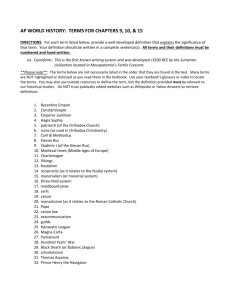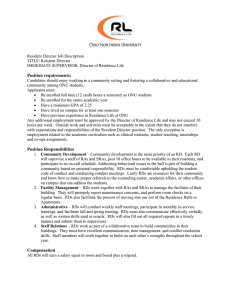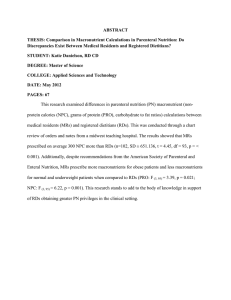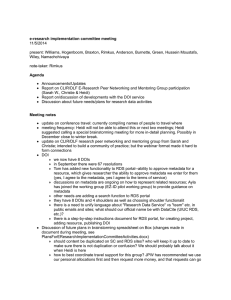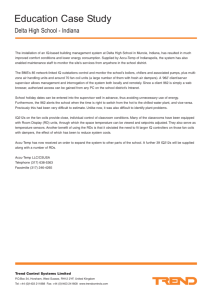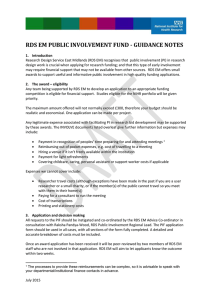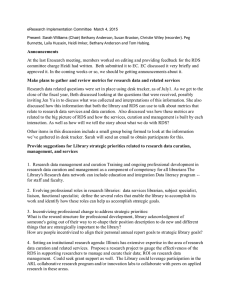Document 12071378
advertisement
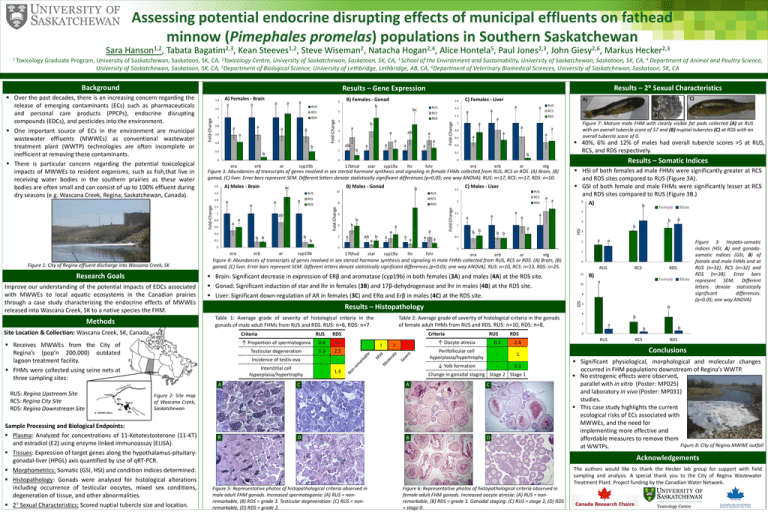
Assessing potential endocrine disrupting effects of municipal effluents on fathead minnow (Pimephales promelas) populations in Southern Saskatchewan Graduate Program, University of Saskatchewan, Saskatoon, SK, CA. 2Toxicology Centre, University of Saskatchewan, Saskatoon, SK, CA, 3 School of the Environment and Sustainability, University of Saskatchewan, Saskatoon, SK, CA, 4 Department of Animal and Poultry Science, University of Saskatchewan, Saskatoon, SK, CA, 5Department of Biological Science, University of Lethbridge, Lethbridge, AB, CA, 6Department of Veterinary Biomedical Sciences, University of Saskatchewan, Saskatoon, SK, CA Background a a a a a 6 a a a a 0.6 a 0.4 0.2 0 era a a a Site Location & Collection: Wascana Creek, SK, Canada erb ar cyp19b a a A) Males - Brain a 40%, 6% and 12% of males had overall tubercle scores >5 at RUS, RCS, and RDS respectively. 0.4 b Results – Somatic Indices 0 17bhsd star cyp19a lhr B) Males - Gonad ac era fshr a a a 1.2 1 0.8 0.6 a RCS a RDS ab a b b b erb ar vtg b b a ab a b a a a a a a a ar cyp19b 1.5 RDS a a a b b a a star cyp19a lhr fshr era erb ar vtg Results – Histopathology Table 2: Average grade of severity of histological criteria in the gonads of female adult FHMs from RUS and RDS. RUS: n=10, RDS: n=8. A ↑ Proportion of spermatogonia 0.8 3.6 Testicular degeneration 0.3 2.5 Incidence of testis-ova - - Interstitial cell hyperplasia/hypertrophy - 1.6 Criteria - C 1 2 3 RUS ↑ Oocyte atresia 0.2 Perifollicular cell hyperplasia/hypertrophy A) ↓ Yolk formation B) - RDS 2.6 1 0.2 Change in gonadal staging Stage 2 Stage 1 A C Figure 2: Site map of Wascana Creek, Saskatchewan Sample Processing and Biological Endpoints: Plasma: Analyzed for concentrations of 11-Ketotestosterone (11-KT) and estradiol (E2) using enzyme linked immunoassay (ELISA). Tissues: Expression of target genes along the hypothalamus-pituitarygonadal-liver (HPGL) axis quantified by use of qRT-PCR. Morphometrics: Somatic (GSI, HSI) and condition indices determined. Histopathology: Gonads were analysed for histological alterations including occurrence of testicular oocytes, mixed sex conditions, degeneration of tissue, and other abnormalities. 2° Sexual Characteristics: Scored nuptial tubercle size and location. C) B D B D) D Female b Male b 3 a a 1 0 RUS 12 10 B) RCS RDS Female a Male 8 GSI Brain: Significant decrease in expression of ERβ and aromatase (cyp19b) in both females (3A) and males (4A) at the RDS site. Gonad: Significant induction of star and lhr in females (3B) and 17β-dehydrogenase and lhr in males (4B) at the RDS site. Liver: Significant down-regulation of AR in females (3C) and ERα and Erβ in males (4C) at the RDS site. RDS b b 2 Figure 4: Abundances of transcripts of genes involved in sex steroid hormone synthesis and signaling in male FHMs collected from RUS, RCS or RDS. (A) Brain, (B) gonad, (C) liver. Error bars represent SEM. Different letters denote statistically significant differences.(p<0.05; one way ANOVA). RUS: n=10, RCS: n=13, RDS: n=25. RUS A) 4 0 17bhsd 6 5 a b b HSI of both females ad male FHMs were significantly greater at RCS and RDS sites compared to RUS (Figure 3A). GSI of both female and male FHMs were significantly lesser at RCS and RDS sites compared to RUS (Figure 3B.) a a 1 0.5 a 0 erb RUS 2 RDS 4 C) Males - Liver RCS RCS 6 2 b 2.5 RUS 8 Fold-Change 1.4 b 10 RUS 1.6 Figure 7: Mature male FHM with clearly visible fat pads collected (A) at RUS with an overall tubercle score of 57 and (B) nuptial tubercles (C) at RDS with an overall tubercle score of 0. HSI 1.8 Criteria Receives MWWEs from the City of Regina’s (pop’n 200,000) outdated lagoon treatment facility. FHMs were collected using seine nets at three sampling sites: a a a a B) RDS a 0.8 0.6 RCS a a 1 RUS a 0.2 Table 1: Average grade of severity of histological criteria in the gonads of male adult FHMs from RUS and RDS. RUS: n=6, RDS: n=7. Methods a a a a C) A) C) Females - Liver Figure 3: Abundances of transcripts of genes involved in sex steroid hormone synthesis and signaling in female FHMs collected from RUS, RCS or RDS. (A) Brain, (B) gonad, (C) liver. Error bars represent SEM. Different letters denote statistically significant differences.(p<0.05; one way ANOVA). RUS: n=17, RCS: n=17, RDS: n=10. era Created by Peter Downing – Educational Media Access and Production © 2011 ab a b 1.2 RDS 0 0 Improve our understanding of the potential impacts of EDCs associated with MWWEs to local aquatic ecosystems in the Canadian prairies through a case study characterizing the endocrine effects of MWWEs released into Wascana Creek, SK to a native species the FHM. ab 1 b 0.2 Research Goals 2 1.4 RCS b a 3 b 0.4 Figure 1: City of Regina effluent discharge into Wascana Creek, SK 4 RUS bc 5 RDS 1 1.6 b RUS RCS 0.8 B) Females - Gonad Fold-Change Fold-Change 1.2 A) Females - Brain Fold-Change 1.4 Fold-Change Over the past decades, there is an increasing concern regarding the release of emerging contaminants (ECs) such as pharmaceuticals and personal care products (PPCPs), endocrine disrupting compounds (EDCs), and pesticides into the environment. One important source of ECs in the environment are municipal wastewater effluents (MWWEs) as conventional wastewater treatment plant (WWTP) technologies are often incomplete or inefficient at removing these contaminants. There is particular concern regarding the potential toxicological impacts of MWWEs to resident organisms, such as fish,that live in receiving water bodies in the southern prairies as these water bodies are often small and can consist of up to 100% effluent during dry seasons (e.g. Wascana Creek, Regina, Saskatchewan, Canada). RUS: Regina Upstream Site RCS: Regina City Site RDS: Regina Downstream Site Results – 2° Sexual Characteristics Results Results–- Gene Histopathology Expression Fold-Change 1 Toxicology Sara Hanson1,2, Tabata Bagatim2,3, Kean Steeves1,2, Steve Wiseman2, Natacha Hogan2,4, Alice Hontela5, Paul Jones2,3, John Giesy2,6, Markus Hecker2,3 6 Figure 3: Hepato-somatic indices (HSI, A) and gonadosomatic indices (GSI, B) of female and male FHMs and at RUS (n=32), RCS (n=32) and RDS (n=38). Error bars represent SEM. Different letters denote statistically significant differences. (p<0.05; one way ANOVA) b 4 b 2 a 0 RUS b b RCS RDS Conclusions Significant physiological, morphological and molecular changes occurred in FHM populations downstream of Regina’s WWTP. No estrogenic effects were observed, parallel with in vitro (Poster: MP025) and laboratory in vivo (Poster: MP031) studies. This case study highlights the current ecological risks of ECs associated with MWWEs, and the need for implementing more effective and affordable measures to remove them Figure 8: City of Regina MWWE outfall at WWTPs. Acknowledgements Figure 5: Representative photos of histopathological criteria observed in male adult FHM gonads. Increased spermatogonia: (A) RUS = nonremarkable, (B) RDS = grade 3. Testicular degeneration: (C) RUS = nonremarkable, (D) RDS = grade 2. Figure 6: Representative photos of histopathological criteria observed in female adult FHM gonads. Increased oocyte atresia: (A) RUS = nonremarkable, (B) RDS = grade 3. Gonadal staging: (C) RUS = stage 2, (D) RDS = stage 0. The authors would like to thank the Hecker lab group for support with field sampling and analysis. A special thank you to the City of Regina Wastewater Treatment Plant. Project funding by the Canadian Water Network.
